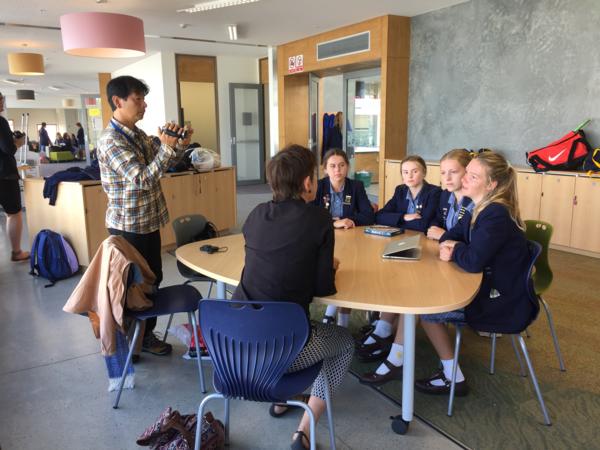Happiness on the Agenda As Japanese Prof Visits Rangi Ruru Today
Tuesday 28 February 2017, 3:59PM
By RedPR
567 views
Rangi Ruru Girls’ School has been selected by Christchurch’s Science Alive to participate in a Japanese-run project called Picture Happiness on Earth.
The National Museum of Emerging Science and Innovation in Tokyo, called Miraikan (pronounced Mir-eye kin) launched the Picture Happiness on Earth project in September 2015.
It connects teenagers from six countries in the Asia Pacific region so they can consider global issues from multiple scientific and ethnical perspectives and this year South Korea, Taiwan, Japan, Australia, Thailand and New Zealand have been selected to take part.
The theme of the project is “What is Happiness?” and the Rangi Ruru students are using scientific data to seek out and define their idea of happiness, delving into how future generations can make positive steps to reach a global state in which people can feel safe, secure, fulfilled, healthy and happy.
Science Alive is hosting the project in New Zealand on behalf of Miraikan with 100 students from Rangi Ruru’s Year 10 (ages 14/15) involved in a series of full day workshops which ran from 8th February to Wednesday 15th February.
Each group of 4 girls will create a video which will be voted on worldwide, with one girl from the winning group being flown to Miraikan to speak at the Science Centre World Summit later this year. The winning work will be made available as video content on the Geo-Sphere (that’s the huge globe you can see on their website) at Miraikan in Tokyo.
Dr Akiyuki Irikawa from Miraikan visited Rangi Ruru today (28th February) as part of his Asia Pacific tour, to meet groups taking part in the project. Of the work the Rangi girls are undertaking, he says, “I hope their real voices will inspire many other students”.
Rangi Ruru Science Teacher Anne Bissland says the phrase ‘global citizenship’ is bandied around a fair bit in education these days and being a part of Picture Happiness on Earth is a good example of walking the talk.
“This is a significant opportunity for our girls, sharing knowledge to help solve problems around the world. That’s really a key part of being a good global citizen,” she says. “It shows the power we all have to raise awareness of global issues and solutions on a world-wide stage and as technology changes, that will become even more important and common.”
Science Alive Community Manager Anna Baker, says one of the key things was that Rangi Ruru could be flexible enough to include the project across the entire Year 10 curriculum.
“They have changed their Year 10 curriculum across a number subjects to accommodate the project which is great. Not all schools can do that. The filming for the video is being used in the English classes for example, the statistics and analysis of those numbers support their learning in maths. It’s an excellent project for all of us,” she says.
ENDS www.rangiruru.school.nz
Additional:
Timeline:
February – 8th-15th each year 10 class does a one day workshop.
Mid-February – students create a video.
February 28th – Dr Irikawa from Miraikan visits Rangi Ruru to meet and speak with the girls about their work.
March – students’ videos go online.
April – public voting
May – winner selected. One person from group goes to Japan in November to present their work.
Miraikan started the TSUNAGARI Project in 2011 which encouraged people to search together for solutions to the challenges facing all life forms to aid the sustainability of Earth. https://www.miraikan.jst.go.jp/en/ The Picture Happiness on Earth Project comes from the TSUNAGARI Project.
Picture Happiness on Earth Project
The project’s mission is, together with people from around the world, to increase knowledge of the self, think of what we should do to pass the current vibrant Earth on to the future, and create a vision for the future.
What do the students do?
Consider what makes them happy
Extrapolate this idea to local environmental issues
Expand thinking to global issues.
Research an issue, accessing data from Geoscope.
Learn to interpret data and use knowledge to construct an answer to one of the global debates.
Storyboard
Create a video
Enter competition. One Year 10 student goes to Japan.
Skills Developed
- Collaboration to discuss issues related to sustainability of Earth.
- Research information from reliable sources
- Interpret data and use results to forge ideas, generate questions and make predictions
- Gain personal, community and global perspective.
- Design, research, analyse and organise information to produce a storyboard and video to express your ideas.
Miraikan
National Museum of Emerging Science and Innovation in Tokyo.
Video of the Globe at Miraikan https://www.youtube.com/watch?v=YD0vP2j8fHo
The six countries this year:
South Korea
Taiwan
Japan
Australia
Thailand
New Zealand
